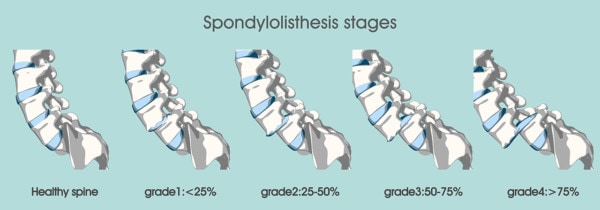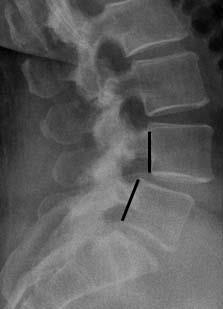Ask Dr. C – Treating Degenerative Spondylolisthesis Without Surgery
A reader asked about my low back spondylolisthesis and how I was doing. So let’s dive into that diagnosis and what can be done. We’ll also cover how these treatments are sequenced. Let’s dig in.
What Is Spondylolisthesis?
Spondylolisthesis is a Latin word that can be broken down to “spondy” which means spine and “listhesis” which means slipped. Hence, it’s a slipped spine. There are two main types. One is where the bone that usually separates the facet joints (pars interarticularis or “part between the joints”) is broken because of trauma or it was never attached from birth (congenital). The more common type is degenerative. This is when the facet joints in the spine get arthritis and as they change shape, they allow one vertebra to move forward on the other. When this happens this is called degenerative spondylolisthesis.

Kit1114/Shutterstock

My Back
I hurt my back in residency. I was in a roll-over car crash and broke three transverse processes and was in a TLSO brace for 6 weeks. It healed, but by my thirties, it started to give out with bouts of severe pain. Initially, I got steroid epidurals and while these worked, they were all like a “sugar high”. Meaning, it all felt good for a while, but then the pain relief crashed fast. When we switched to using platelet lysate epidurals instead of steroids, the relief lasted longer. When we switched to also treating my facets, ligaments, and multifidus muscles my back began to improve more permanently. Somewhere in there, we noticed that I was getting a degenerative spondylolisthesis, but after several more treatments that resolved.
How is my back today? All things considered, pretty good. I can now do things that just a few years ago I avoided like the plague. For example, I helped my son move this winter with big lifting involved. My back did fine. Just a few years ago I would have paid for that for weeks or needed additional immediate treatment.
The Question
“In one of your earlier blogs you’ve mentioned your own treatments for spondylolisthesis, how are your treatments going and how often do you require ‘maintenance’ injections?
I’m asking because back in October I had regenexx PRP and PL treatment for moderate herniation, DDD at L3, L4, L5 and S1. I felt great and considered it a big success. But this week I’ve had a relapse, seized up, can’t stand up straight and in lots of pain. (crooked back, I think the bulge prolapsed)
I’m going to get a second treatment, I’ve read from you and others that the second treatment can be necessary. But I don’t think I want to be taking treatments every few months for the rest of my life. I’m curious to hear what you’d consider a nominal expectation for non surgical maintenance treatments.”
To answer this question, let’s dig in a bit on how this procedure works and what it’s called. We call the second procedure we performed on my back a “DDD” procedure (DDD=Degenerative Disc Disease”). This procedure injects either platelet based products (high dose platelet-rich plasma, platelet lysate, and platelet-poor plasma) or bone marrow stem cells into the:
- Ligaments
- Epidural (around the irritated nerves)
- Facets
- Multifidus muscles
- Painful tendons
- Sometimes, when needed, the disc
To learn more, see my video below:
How Often Do These Procedures Take Place?
For spondylolisthesis, one of the primary goals of these procedures is to tighten down loose ligaments and reduce that slippage as you move. This doesn’t happen all at once and hence usually these DDD procedures are recommended every 1-2 months for 2-4 injection sessions to get those ligaments tightened down. While it’s possible that a single treatment could be all that someone needs, it’s unlikely based on my clinical experience.
Instability has two components. One is loose ligaments, but the other is weak muscles. The muscles that are critical here to stabilize the low back are those that support the core. These are the glutes, abs, deep abs like transversus abdominus, and the deep low back muscles like multifidus. Hence, after the back is tightened down and the patient is able to work on strengthening these muscles, it’s rare that we need to perform other back injections unless something else happens (another injury). Or for some patients with more severe disease, they get tune-up injections once every few years.
Hence, for most patients, the plan looks like this:
- The first DDD injection procedure for proof of concept
- A total of 2-4 procedures every 1-2 months
- 3-12 months of intensive core strengthening that can begin as soon as the low back is less symptomatic
The upshot? We routinely treat degenerative spondylolisthesis. However, it’s rare that this is a “one and done” treatment. It’s more common that the therapy will take several treatments plus rehab to get the patient back where they need to be.

NOTE: This blog post provides general information to help the reader better understand regenerative medicine, musculoskeletal health, and related subjects. All content provided in this blog, website, or any linked materials, including text, graphics, images, patient profiles, outcomes, and information, are not intended and should not be considered or used as a substitute for medical advice, diagnosis, or treatment. Please always consult with a professional and certified healthcare provider to discuss if a treatment is right for you.
